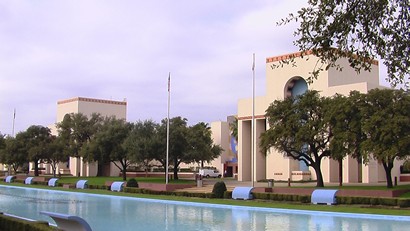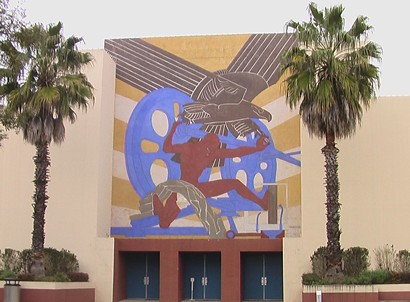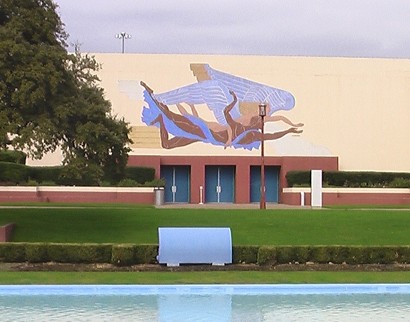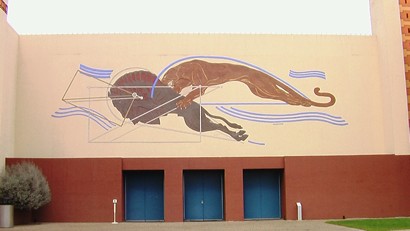|
When
the Dallas State Fair made its only appearance in 1886, the year
before it merged to become the State Fair of Texas, one of the main
attractions was a wooden structure called the Exposition Building,
despite the fact that there was no exposition. Its 140,000 feet
of space served as a marketplace for companies and individuals wanting
to sell their products that included pianos, alcohol, clothing,
trunks, jewelry, saddles, sewing machines, hardware, quilts, and
tobacco. It became the perfect place for exhibits, meetings, reunions,
and public events when not being used for the fair.
In 1902, a blazing fire burned the structure to the ground, forcing
officials to build a new one. Construction began in 1905 and opened
at its current location the following year. Everyone called it the
Exposition Building for thirty years. During that time, it
served as a place for individuals, small businesses, and corporations
to promote and sell their products at the state fair. Things would
change in 1936 with the Texas
Centennial Exposition.
|
 |
Centennial
Building
Photo courtesy Clint Skinner, February 2016 |
|
For
the grand celebration, the Exposition Building had an extra wing
added to it while the exterior was completely remodeled to reflect
the popular art style of the time. In addition, statues were sculpted
and placed in front of the three main entrances facing the esplanade
pool. George Dahl wanted the artwork to represent the nations
that ruled over Texas at one time or the other. There would be three
statuaries for the Exposition Building and three for the structure
on the other side. Designed by Lawrence Tenney Stevens, the twenty-foot
female figures stood in front of a portico that covered each of
the entrances.
|
Centennial
Building Spain Portico
Photo courtesy Clint Skinner, February 2016 |
|
During the centennial,
the main section was called the Travel and Transportation Building
and the new wing was called the Chrysler Building. Dahl decided
it would be best to have artwork at each portico that reflected
the structure's theme. He picked Carlo Ciampaglia to complete the
task, resulting in the composition of six wall murals in the art
deco style.
|
Centennial
Building Texas Portico - Rail Transportation Mural
Photo courtesy Clint Skinner, February 2016 |
Centennial
Building Texas Portico - Navigation Mural
Photo courtesy Clint Skinner, February 2016 |
The
first portico that visitors encounter when arriving from the main
entrance belongs to Spain. Its flag flew over Texas from 1519 to
1685 and 1690 to 1821. The nation's interest in Texas was minimal
at best during the first part of its occupation. It all started
with explorer Cabeza
de Vaca, whose name means Cow's Head. His venture into the North
America in 1527 resulted in the starvation, death, and enslavement
of everyone who joined him. Only four managed to escape their captors,
various tribal bands living in the Galveston region. Estaban returned
from his ordeal with stories of golden cities. This eventually led
to the Coronado
Expedition of 1540. In addition to exploring the untouched wilderness
of North America, Francisco de Coronado sought to settle the validity
of the stories of gold and riches. His journey led him through the
Texas panhandle.
When he returned home, Coronado faced a series of inquiries, where
he revealed that no riches could be found.
Interest in Texas quickly faded with the exception of maybe a few
missions. This all changed when France tried to colonize the area.
Spain reacted by sending priests into the region to convert the
native people and setting up small colonies. Spain's territorial
reign ended with the establishment of Mexico.
|
 |
Man
and Eagle
Photo courtesy Clint Skinner, February 2016 |
|
To the right
of the Spanish portico is a cement bas-relief featuring a man, an
eagle, train wheels, and railroad tracks. The artwork as a whole
symbolizes the conflict between nature and machine or reflects the
power necessary to move a train, depending on who is consulted as
an interpreter. It was made from the hands of a French artist named
Pierre Van Parys Bourdelle. Born in Paris, he worked under the guidance
of Auguste Rodin after fighting in World
War I and studied at two schools in the capitol city. In 1929,
he moved to America and made large scale paintings, murals, and
reliefs in New York City during the 1930s and 1940s. Bourdelle,
however, performed many tasks outside the city. The Texas exposition
was one of them.
|
Confederacy
Portico
Photo courtesy Clint Skinner, February 2016 |
|
The
second portico represents the Confederacy. Its flag flew over Texas
from 1861 to 1865. The issue of secession was a contention one of
Texas, sometimes leading to violence. In the end, the state legislature
voted in favor of the proposition and removed Governor Sam
Houston from office because of his opposition. The former republic's
first president disappeared from the public scene and stayed in
Huntsville until
he died from pneumonia in 1863.
|
Confederacy
Portico - Future Transportation Mural
Photo courtesy Clint Skinner, February 2016 |
Confederacy
Portico - Old Methods of Transportation Mural
Photo courtesy Clint Skinner, February 2016 |
|
Texas
played an important part in providing food and raw materials for
the South. The North tried to prevent this from happening by sending
its navy forces to Galveston
as part of a blockade along the Gulf of Mexico. As part of the Texas
Coast division, Commander William B. Renshaw led eight ships to
capture Galveston
in October 1862. The Union boats barraged Fort Point after they
received several ineffective shots. Looking at the situation, Joseph
J. Cook, who was in charge of the Confederate fortifications, came
to the conclusion that the stronghold could not be successfully
defended. He asked Renshaw for a four-day truce and got it. After
the agreement went into effect, Cook spent his time sending all
the men and supplies to the nearby coast. The Union forces took
control of the harbor, but they did not move inland until December.
Meanwhile, Major General John B. Magruder was sent to retake Galveston
Bay. Wanting to redeem himself after his poor performance during
the Seven Days Campaign, Magruder made his plans in Houston.
He then moved his forces and attacked on New Year's Day. One force
would attack by land while another force would assault the navy.
Things did not go well. After the army was pushed back, one of the
two Confederate ships fell into the watery depths. Out numbered
six to one, all seemed lost until the Bayou City managed
to sink one of the ships. Renshaw's own vessel got stuck on a sandbar
and a truce was issued. The Union commander destroyed his ship during
the respite so it wouldn't fall into enemy hands. Unfortunately,
he died from the explosion. This series of events convinced the
remaining naval crews to escape and retreat. Weary of fighting,
the Confederate forces decided not to pursue them. This victory
allowed Galveston
to remain an open port for trade throughout the war.
|
 |
Centennial
Building Man and Angel
Photo courtesy Clint Skinner, February 2016 |
|
Going
past the second portico, visitors will encounter the second bas-relief
made by Pierre Bourdelle. Showing a man being carried by an angel,
the artwork symbolizes air travel.
|
Centennial
Building - Texas Portico
Photo courtesy Clint Skinner, February 2016 |
Texas
Portico - Aeroplane Transportation Mural
Photo courtesy Clint Skinner, February 2016 |
Centennial
Building Texas Portico - Automotive Transportation
Photo courtesy Clint Skinner, February 2016 |
|
The
final portico of the Centennial Building represents the Republic
of Texas. Its flag flew over Texas from 1836 to 1845. The period
began with the victory over the Mexican Army led by Santa Anna.
leading to the end of the Texas Revolution. On April 21st, the Mexican
president and his men were taking a peaceful rest during the late
afternoon at San
Jacinto. General Sam
Houston learned about the respite and decided to take advantage
of the situation. Under his command, the Texans took the opposing
forces by complete surprise, resulting in a battle
that lasted only eighteen minutes. A day later, Santa Anna was
captured while retreating and forced into signing a treaty which
recognized Texas Independence.
Upon becoming an independent nation, the Texas government formed
a constitution very similar to the one used by the United States.
The document called for an executive branch headed by a president
who would stay in office for three years. However, the person could
not run for re-election. The Congress consisted of the House of
Representatives and the Senate. The House would have twenty to forty
members until the country's population reached 100,000. Afterward,
it would be allowed to have forty to one hundred representatives.
The Senate had no set number of politicians. The Constitution said
that the body need to have at least one-third of the number of House
representatives but not exceed fifty percent of that same amount.
There was a supreme court like the United States, but it had five
judges instead of nine. The president appointed the chief justice
and the Congress picked the remaining four. All of them served a
period of four years, but they could be re-elected unlike the executive
branch.
The new nation faced the problem of settlement raiding by the various
Indian tribes, the Comanche and Cherokee being the most active among
them. Making things worse, two approaches clashed over the issue
of what to do about the attacks. Sam
Houston and his supporters wanted peace and advocated making
treaties while Mirabeau
B. Lamar's group favored a militaristic response. With a different
leader every three years, one side would cancel out the work of
the other. In the end, Houston
won the battle with a successful treaty involving the remaining
tribes.
The problem with the Native Americans was nothing compared to the
financial difficulties facing the new nation. By the time Texas
finally won its independence, the government had acquired a debt
reaching over one million dollars. There was no currency at the
moment, so it had to rely on bank notes. This wasn't helped by a
complicated bank system and the ever-increasing deficit. The government
eventually printed money, which became known as redbacks. Unfortunately,
they only survived for three years. This lack of a strong financial
backbone forced the government to rely on the sale of land for the
funding of its programs and daily functions.
While this was going on, many people wanted to annex Texas to the
United States. Indeed, there was a call for such action even before
the nation won its independence. The members of the first Congress
voted on the matter with a majority in favor of joining the Union.
However, the political environment in America prevented annexation
from happening. Sam
Houston brought the matter to President John Tyler in 1844 and
a law was passed the following year, making Texas the twenty-eighth
state.
|
 |
Centennial
Building Bison and Cougar
Photo courtesy Clint Skinner, February 2016 |
The
third Bourdelle relief is located to the right of the final portico.
It depicts a bison trying unsuccessfully to outrun a cougar. The
artwork represents ground transportation.
At the end of the building, the fourth and final work by Pierre
Bourdelle awaits. It shows man's attempt to tame horses in the same
manner he has tamed water. Symbolizing water transportation, the
art is displayed on a wall behind an anchor stationed on a concrete
base. The anchor was given by the United States Navy in 1971 to
show thanks for the state fair's continued support.
|
Centennial
Building Man and Horse
Photo courtesy Clint Skinner, February 2016 |
Although
the exact year remains a mystery, the public started referring to
the vast structure as the Centennial Building after the two
expositions ended. In 1942, its mirror image on the other side of
the esplanade poll burned to the ground. There were no plans for
reconstructing the murals for the planned replacement, so officials
decided to paint over Carlo Ciampaglia's paintings at the Centennial
Building. This would allow the two structures to mirror each other.
The paint began flaking in the early 1960s, resulting in another
layer of paint. This practice continued until there were six coats
covering the artwork.
Efforts to restore the murals began in 1999. Founded by Scott Haskins,
Fine Art Conservation Laboratories, a specialized company which
had been in business since the 1970s, faced the difficult task of
recovering the centennial remnants of the Centennial Building. Haskins
also had to deal with all the other neglected artwork in Fair Park.
The restoration was a long, hard process that was successfully completed
in 2000.
|
References:
1.Bigtex.com
2.Dallashistory.org
3.Dallas Morning News Archives
4.Fairpark.org
5.Slate, John H. Historic Dallas Parks. Arcadia Publishing, 2010.
6.Tshaonline.org
7.Watermelon-kid.com
8.Wikipedia.org
8.Winters, Willis Cecil. Fair Park. Arcadia Publishing, 2010. |
|
|
| Texas
Escapes, in its purpose to preserve historic, endangered and vanishing
Texas, asks that anyone wishing to share their local history, stories,
landmarks and vintage or recent photos, please contact
us. |
|
|
